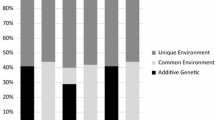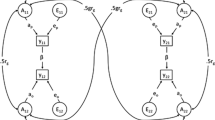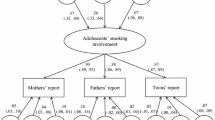Abstract
This paper examines genetic contribution to suicidal behaviors and other risk factors associated with suicidal behavior among adolescents in the U.S. Using adolescent twin data in the National Longitudinal Study of Adolescent Health (N=1448), we compared concordance in suicidal ideation and attempt among monozygotic (MZ) and dizygotic (DZ) twins. Heritability of risk factors for suicidal behaviors also was examined using Pearson correlation and mixed-model analyses. A trend of higher concordance in suicidal ideation and attempt was found among MZ than DZ twins but the difference was not statistically significant by the stringent test of bootstrapping analysis. Evidence of heritability was found for several suicide risk factors. The percentage of variance explained by heritability was larger among female twins for depression, aggression, and quantity of cigarettes smoked in comparison to heritability estimates for male twins. However, estimated heritability was larger among male than female twins for alcohol use and binge drinking. Heritability influence was negligible among both sexes for other drug use. Risk factors for suicidal behaviors among adolescents may be heritable. Gender differences found in the heritability of some suicide risk factors suggest these genetic contributions are gender specific. Future research examining potential interactions between expression of genetic influence and particular environmental contexts may enhance prevention and intervention efforts.
Similar content being viewed by others
References
Anderson R.N., Smith B.L. (2005). Deaths: Leading causes for 2002. National vital statistics reports: National Center for Health Statistics. Volume 53, Number 17.
Bearman, P. S., & Moody, J. (2004). Suicide and friendships among American adolescents. American Journal of Public Health, 94, 89–95.
Brent, D. A., Kolko, D. J., Wartella, M. E., Boylan, M. B., Moritz, G., Baugher, M., et al. (1993). Adolescent psychiatric inpatients’ risk of suicide attempt at 6-month follow-up. Journal of the American Academy of Child and Adolescent Psychiatry, 32, 95–105.
Brent, D. A., Bridge, J., Johnson, B. A., & Connolly, J. (1996). Suicidal behavior runs in families. A controlled family study of adolescent suicide victims. Archives of General Psychiatry, 53, 1145–1152.
Bridge, J. A., Brent, D. A., Johnson, B. A., & Connolly, J. (1997). Familial aggregation of psychiatric disorder in a community sample of adolescents. Journal of the American Academy of Child and Adolescent Psychiatry, 36, 628–636.
Brook, J. S., Cohen, P., & Brook, D. W. (1998). Longitudinal Study of Co-occurring Psychiatric Disorders and Substance Use. Journal of the American Academy of Child and Adolescent Psychiatry, 37, 322–330.
Brooks, T. L., Harris, S. K., Thrall, J. S., & Woods, E. R. (2002). Association of adolescent risk behaviors with mental health symptoms in high school students. Journal of Adolescence Health, 31, 240–246.
Burge, V., Felts, M., Chenier, T., & Parrillo, A. V. (1995). Drug use, sexual activity, and suicidal behavior in U.S. high school students. Journal of School Health, 65, 222–227.
Centers for Disease Control and Prevention (2004). Youth Risk Behavior Surveillance-United States 2003. Surveillance Summaries MMWR 2004, 53 (No.SS-2), 1-96. Retrieved May 21, 2004, from http://www.cdc.gov/mmwr/preview/mmwrhtml/ss5302a1.htm.
Centers for Disease Control and Prevention (1996). Youth Risk Behavior Surveillance-United States 1995. Surveillance Summaries MMWR 1996, 45 (No.SS-4), 1-86. Retrieved from http://www.cdc.gov/mmwr/PDF/SS/SS4504.pdf.
Cleveland, H. H. (2003). Disadvantaged neighborhoods and adolescent aggression: Behavioral genetic evidence of contextual effects. Journal of Research on Adolescence, 13, 211–238.
Cleveland, H. H., & Wiebe, R. P. (2003). The moderation of genetic and shared-environmental influences on adolescent drinking by levels of parental drinking. Journal of Studies on Alcohol, 64, 182–194.
Efron, B., & Tibshirani, R. J. (1993). An Introduction to the Bootstrap. New York: Chapman & Hall.
Felts, W. M., Chenier, T., & Barnes, R. (1992). Drug use and suicide ideation and behavior among North Carolina public school students. American Journal of Public Health, 82, 870–872.
Glowinski, A. L., Bucholz, K. K., Nelson, E. C., Fu, Q., Madden, P. A. F., Reich, W., et al. (2001). Suicide attempts in an adolescent female twin sample. Journal of the American Academy of Child and Adolescent Psychiatry, 11, 1300–1302.
Gould, M. S., Fisher, P., Parides, M., Flory, M., & Shaffer, D. (1996). Psychosocial risk factors of child and adolescent completed suicide. Archives of General Psychiatry, 53, 155–162.
Gould, M., King, R., Greenwald, S., Fisher, P., Schwab-Stone, M., Kramer, R., et al. (1998). Psychopathology associated with suicidal ideation and attempts among children and adolescents. Journal of the American Academy of Child and Adolescent Psychiatry, 37, 915–923.
Gould, M. S., Greenberg, T., Velting, D. M., & Shaffer, D. (2003). Youth suicide risk and preventive interventions: a review of the past 10 years. Journal of the American Academy of Child and Adolescent Psychiatry, 42, 386–405.
Guo, G. (2005). Twin studies: What can they tell us about nature and nuture? Contexts, 4, 43–47.
Guo, G., & Wang, J. (2002). The mixed or multilevel model for behavior genetic analysis. Behavior Genetics, 32, 37–49.
Hallfors, D., Waller, M. W., Ford, C. A., Halpern, C. T., Brodish, P. H., & Iritani, B. (2004). Adolescent depression and suicide risk: Association with sex and drug behavior. American Journal of Preventive Medicine, 27, 224–230.
Harris, K. M., Frorey, F., Tabor, J., Bearman, P. S., Jones, J., & Udry, J. R. (2003). The National Longitudinal Study of Adolescent Health: Research Design [WWW document]. Retrieved from http://www.cpc.unc.edu/projects/addhealth/design.
Jacobson, K. C., & Rowe, D. C. (1998). Genetic and Shared Environment Influences on Adolescent BMI: Interaction with Race and Sex. Behavior Genetics, 28, 265–278.
Jacobson, K. C., & Rowe, D. C. (1999). Genetic and environmental influences on the relationships between family connectedness, school connectedness, and adolescent depressed mood: Sex differences. Developmental Psychology, 35, 926–939.
Jessor, R., Jessor, S. L., & Finney, J. (1973). A social psychology of marijuana use: longitudinal studies of high school and college youth. Journal of Personal and Social Psychology, 26, 1–15.
Johnson, B. A., Brent, D. A., Bridge, J., & Connolly, J. (1998). The familial aggregation of adolescent suicide attempts. Acta Psychiatrica Scandinavica, 97, 18–24.
Kandel, D. B., Raveis, V. H., & Davies, M. (1991). Suicidal ideation in adolescence: Depression, substance use, and other risk factors. Journal of Youth and Adolescence, 20, 289–309.
King, R. A., Schwab-Stone, M., Flisher, A. J., Greenwald, S., Kramer, R. A., Goodman, et al. (2001). Psychosocial and risk behavior correlates of youth suicide attempts and suicidal ideation. Journal of the American Academy of Child and Adolescent Psychiatry, 40, 837–846.
Lewinsohn, P., Rohde, P., & Seeley, J. (1996). Adolescent suicidal ideation and attempts: prevalence, risk factors, and clinical implications. Clinical Psychology, 3, 25–46.
Maccoby, E., & Masters, J. (1970). Attachment and dependency. In P. H. Mussen (Ed.), Carmichael's manual of child psychology. New York: Wiley
Mann, J. J., Waternaux, C., Haas, G. L., & Malone, K. M. (1999). Toward a clinical model of suicidal behavior in psychiatric patients. American Journal of Psychiatry, 156, 181–189.
Miles, D. R., van den Bree, M. B. M., Gupman, A. E., Newlin, D. B., Glantz, M. D., & Pickens, R. W. (2001). A twin study on sensation seeking, risk taking behavior, and marijuana use. Drug and Alcohol Dependence, 62, 57–68.
Miles, D. R., van den Bree, M. B. M., & Pickens, R. W. (2002). Sex differences in shared genetic and environmental influences between conduct disorder symptoms and marijuana use in adolescents. American Journal of Medical Genetics (Neuropsychiatric Genetics), 114, 159–168.
Neale, C. M., & Cardon, L. R. (1992). Methodology for genetic studies of twins and families. Boston/London: Kluwer Academic Publishers.
Nimeus, A., Traskman-Bendz, L., & Alsen, M. (1997). Hopelessness and suicidal behavior. Journal of Affective Disorders, 42, 137–144.
Nordstrom, P., Schalling, D., & Asberg, M. (1995). Temperal vulnerability in attempted suicide. Acta Psychiatrica Scandinavica, 92, 155–160.
O’Connor, R. C., Connery, H., & Cheyne, W. M. (2000). Hopelessness: The role of depression, future directed thinking, and cognitive vulnerability. Psychology, Health & Medicine, 5, 155–161.
Petronis, K. R., Samuels, J. F., Moscicki, E. K., & Anthony, J. C. (1990). An epidemiologic investigation of potential risk factors for suicide attempts. Social Psychiatry and Psychiatric Epidemiology, 25, 193–199.
Robins, L. N., Davis, D. H., & Wish, E. (1977). Detecting predictors of rare events: demographic, family and personal deviance as predictors of stages in the progression toward narcotic addiction. In J. S. Strauss, B. Haroutun, & M. Roff (Eds.), The origins and course of psychopathology (pp. 379–406). New York: Plenum.
Radloff, L. S. (1977). The CES-D Scale: a self-report depression scale for research in the general population. Applied Psychological Measurement, 1, 385–401.
Rowe, D. C., Almeida, D. M., & Jacobson, K. C. (1999). School context and genetic influences on aggression in adolescence. Psychological Science, 10, 277–280.
Roy, A., Segal, J. L., Centerwall, B., & Robinette, D. (1991). Suicide in twins. Archives of General Psychiatry, 48, 29–32.
Roy, A., Segal, N. L., & Sarchiapone, M. (1995). Attempted suicide among living co-twins of twin suicide victims. American Journal of Psychiatry, 152, 1075–1076.
Roy, A., & Segal, N. L. (2001). Suicidal behavior in twins: a replication 2001. Journal of Affective Disorder, 66, 71–74.
Rushton, J. L., Forcier, M., & Schectman, R. M. (2002). Epidemiology of depressive symptoms in the National Longitudinal Study of Adolescent Health. Journal of the American Academy of Child and Adolescent Psychiatry, 41, 199–205.
SAS/STAT User's Guide. (1999). SAS Institute, Cary, NC.
Seale, S. R. (1971). Linear models. New York: Wiley.
Searle, S. R., Casella, G., & McCulloch, C. E. (1992). Variance components. New York: Wiley.
Statham, D. J., Heath, A. C., Madden, P. A. F., Bucholz, K. K., Bierut, L., Dinwiddie, S. H., et al. (1998). Suicidal behaviour: An epidemiological and genetic study. Psychological Medicine, 28, 839–855.
Strachan, T., & Read, A. P. (2000). Human molecular genetics. New York: John Wiley & Sons.
Turecki, G. (2001). Suicidal behavior: is there a genetic predisposition? Bipolar Disorders, 3, 335–349.
Turner, C. F., Ku, L., Rogers, S. M., et al. (1998). Adolescent sexual behavior, drug use, and violence: increased reporting with computer survey technology. Science, 280, 867–873.
Woods, E. R., Lin, Y. G., Middleman, A., Beckford, P., Chase, L., & Durant, R. H. (1997). The association of suicidal attempts in adolescence. Pediatrics, 99, 791–796.
Acknowledgements
This research was supported in part by grant R01-DA14496 from the National Institute on Drug Abuse (Denise Hallfors, P.I.). We wish to thank Seulki Choi and Jianmin Wang for their consultation. This research uses data from Add Health, a program project designed by J. Richard Udry, Peter S. Bearman, and Kathleen Mullan Harris, and funded by grant P01-HD31921 from the National Institute of Child Health and Human Development, with cooperative funding from 17 other agencies. Special acknowledgment is due Ronald R. Rindfuss and Barbara Entwisle for assistance in the original design. Persons interested in obtaining data files from Add Health should contact Add Health, Carolina Population Center, 123 W. Franklin Street, Chapel Hill, NC 27516-2524 (http://www.cpc.unc.edu/projects/addhealth/data/contract).
Author information
Authors and Affiliations
Corresponding author
Rights and permissions
About this article
Cite this article
Cho, H., Guo, G., Iritani, B.J. et al. Genetic Contribution to Suicidal Behaviors and Associated Risk Factors among Adolescents in the U.S.. Prev Sci 7, 303–311 (2006). https://doi.org/10.1007/s11121-006-0042-5
Published:
Issue Date:
DOI: https://doi.org/10.1007/s11121-006-0042-5




